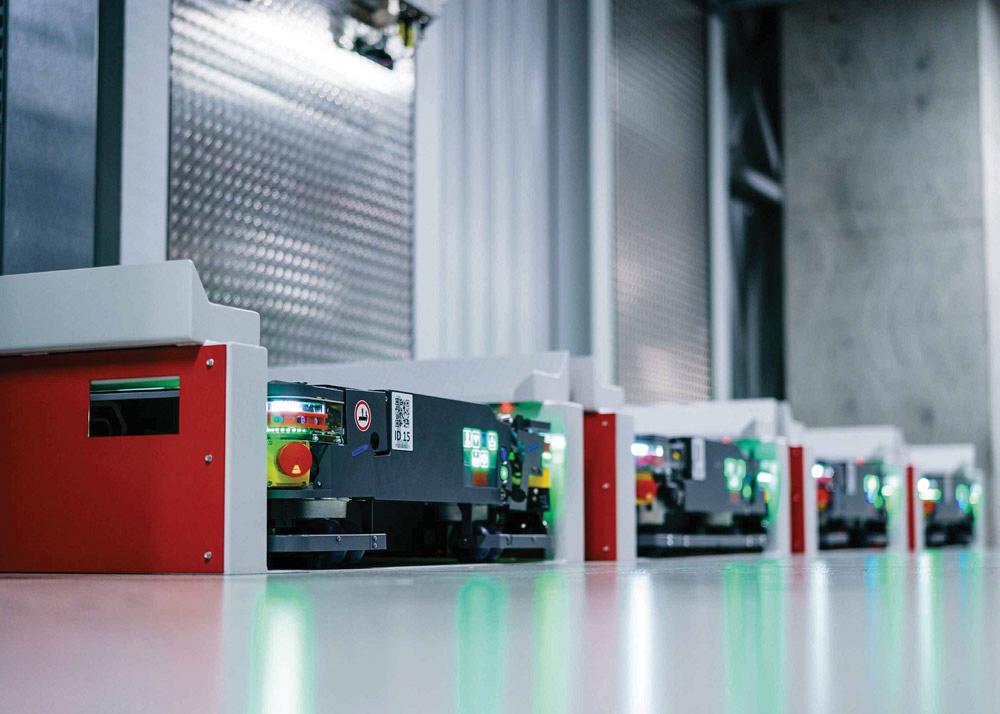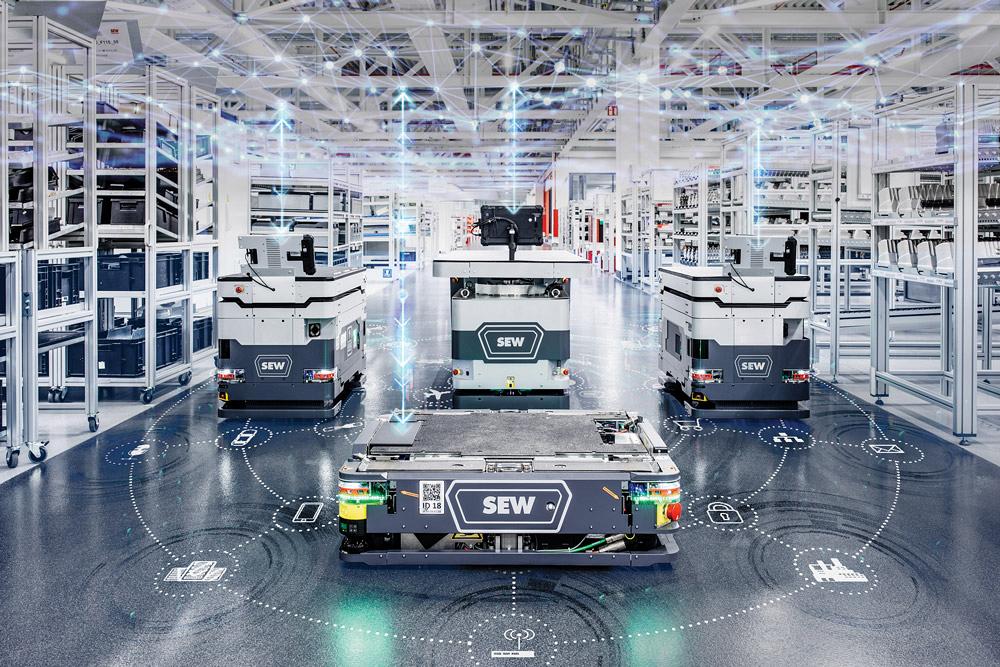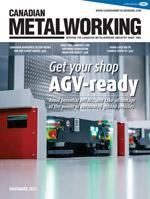Maxolution business manager
- FMA
- The Fabricator
- FABTECH
- Canadian Metalworking
Get your shop AGV-ready
Avoid potential pitfalls, and take advantage of the power of automated guided vehicles
- By Konrad Kurylo
- December 2, 2021
- Article
- Automation and Software

The number of required vehicles is subject to various conditions such as buffering stations, driving distances, single-track zones, passing lanes, location of vehicle depots, location of charging tracks, and charging times.
Safety is one of the biggest reasons that people turn to automated guided vehicles (AGVs). People suffer from fatigue and distraction, whereas an AGV is designed to do tedious routines 24/7. The last thing any shop wants is to lose an employee for health and safety reasons but also to a lack of job satisfaction. AGVs can take over those repetitive tasks, freeing up operators to do value-added, meaningful work.
Many people are confused by the acronym AGV, often assuming the A stands for autonomous. However, automated guided vehicles are quite different from autonomous guided vehicles. Obstacle avoidance, which is indicative of autonomous guided vehicles, is a key differentiator between the two. To dispel the confusion, labels like autonomous mobile robots (AMR) tend to be used for autonomous systems rather than automated ones.
One common misconception is assuming obstacle avoidance is necessary on the shop floor, which results in overpaying for features that might not make sense in all cases. AMRs have their place in warehouse logistics and commercial applications environments, which are constantly changing. However, shops must have an objective viewpoint to understand where this functionality is beneficial and where it could be detrimental to the process; where the implementation is impossible because of limited or complex driving environments; and where it has no value, like a fenced area.
AGVs are best-suited for assembly and production logistics, as the environment does not change. They are part of the sequential process (assembly on the vehicle itself) or feed the process (deliver parts). The paths, sources, and targets are all predefined, and no obstacle avoidance is needed.
AGVs are retrainable quickly and inexpensively. They require no additional cost for overtime, and the machine is always available. Throughput can be increased easily by adding more units, while other systems, like stationary fixed conveyors, are much harder to upgrade. They are designed to work in the machine shop and can be integrated on the shop floor where human interaction is inevitable.
Forklifts within facilities are a wild card. AGVs and people can mix, but mixing AGVs with forklifts is a disaster waiting to happen. Regardless of the safety measures incorporated into the AGV, we can only prevent the unit from hitting a forklift but we can’t stop the forklift from hitting the AGV. Forklifts are flexible and best-suited for a particular area like shipping and receiving, and plant operators should consider that separation. It’s important to have a dedicated forklift zone and a dedicated AGV zone, which can also include people.
People tend to give way to a manually driven forklift because of the potential danger. AGVs have so much redundant safety built into them that everyone is more inclined to walk or drive pass them, knowing the system will stop or react every time, unlike a forklift.
This is the main argument for deploying this technology alongside people, but it can and will impact the performance of the vehicle meeting strict cycle times in a manufacturing environment. If a vehicle is continually stopping because of human obstructions, it may not meet its cycle time requirements. Adding more vehicles to compensate sometimes works against you, since additional units in certain scenarios can create more bottlenecks.
Many shop floor conditions can be simulated, but a few variables cannot be entirely predicted, such as vehicle interaction with the environment (the number of unplanned stops because of safety scanners being activated unless the path is fenced off), floor conditions affecting vehicle dynamics, and overall material transfer via custom tooling.
Choosing a company that has the experience and know-how to design a system based on shop floor needs and can coach shops and workers about potential system pitfalls and possible scenarios, which might not be so obvious, is essential.

AGVs are retrainable quickly and inexpensively. They require no additional cost for overtime, and the machine is always available.
Budget
Adapters of mobile automation must be aware of the different types and nature of available systems on the market. There is no one-size-fits- all solution out there, and shops have a vast array of options to choose from, which have a drastic effect on their overcall capital expense. Its not just the vehicle type, payload, navigation, load handling device, energy storage, charging method; those are mainly related to the cost of hardware.
Shops must also consider the complementary infrastructure, the interface to a high-level process controller, implementation of additional plant safety if required by a pre-start health and safety review (PSR/PHSR), operator training, and even annual licence fees associated with certain systems.
A majority of these additional costs are the same regardless of the size of the AGV fleet or number of operating shifts.
In general, the ROI tends to favour installations where the unit is operated for two or three shifts. Some AGV suppliers offer a range of energy storage options suitable for one or more shifts, but some systems are for 24/7 operation, where the battery can be removed altogether and continuously power the vehicles wirelessly. This allows shops to reduce the overall required number of vehicles and all charging stations, helping to reduce the overall expense.
It’s important for shops to find out in advance if the system requires ongoing annual licence fees or subscriptions and if the AGV supplier has a comprehensive maintenance program.Process
A detailed analysis of the product flow, throughput rates, requirements for future production growth, and overall intralogistics needs to be reviewed. Through a careful analysis of each application, including a real-time simulation based on the actual plant layout, a supplier can recommend the best standard or custom system.
The process itself dictates the number of AGVs required. This is a very careful study, which most of the time requires a simulation of the process, so a shop must be heavily involved. The number of working shifts affects the type of batteries and charging methods needed and ultimately the number of required AGVs.
The number of required vehicles is subject to various additional conditions, such as buffering stations, driving distances, single-track zones, passing lanes, location of vehicle depots, location of charging tracks, and charging times. These will require some significant infrastructure considerations.
A non-battery system that operates via full-time wireless charging eliminates the burden of having to cycle vehicles for staggered charging and the extra cost of vehicles specific to two or more shifts. It eliminates overnight charging, opportunity charging, battery swaps, deep discharge of batteries, routine battery equalization, and extra plant space for charging stations or battery storage. An inductive system is contactless and hence maintenance-free.
Also, depending on the results of the analysis, AGVs might not be the best option. Numerous non-AGV and mobile alternatives are available to bring automation to the shop floor. Rail-guided vehicles are one option, as well as electrified monorail systems (EMS), which tend to be better-suited for faster velocities and longer travel distances.
Again, the initial step is related to the hardware and type of technology that fits a shop’s application. The key is how to homogeneously implement the system into the existing process. Operators must keep an open mind to tweak their existing processes to ensure the system is used to its fullest potential. which in turn results in a faster ROI.

AGVs are perfectly suitable for operations with pedestrians and plant personnel. However, employees need to be trained or briefed on how to interact with the new technology safely.
Infrastructure
For this consideration, IT plays a vital role in looking at complementary supporting equipment and travel routes.
How orders are initiated and processed will depend on a facility’s IT infrastructure. The automated system can be a stand-alone application or can tie into an existing upper-level controller, an enterprise system, or warehouse management system.
Implementation and installation of any additional equipment are also key. Shops do not always have the luxury of endless manufacturing space, so even the location of charging stations could pose a problem. Fire exits, walkways, existing building obstructions, and floor conditions, to name a few, affect the planned driving routes and, more importantly, the cycle rates.
Choosing a supplier that can help and guide a shop through every level of the project will make for a smoother transition.
Customization
Even if a shop doesn’t have a wide product portfolio, sometimes an assembled-to-order (ATO) vehicle is not suitable. In these cases, a shop definitely wants to look for a supplier that can either modify one of the standard vehicles or build a customer/application-specific vehicle to perfectly suit its needs.
This does not require total re-engineering in most cases. The navigation, power, and control system do not change, but the form-factor, frame, or custom load handling unit does get adapted.
The load handling devices (LHD) are fairly common and typically end up being a revision of a previous proven design. These are adapted to the shop’s payload weight and size. This subsystem must also be powered by the AGV itself and hence needs to be considered carefully when the energy storage system is specified, unless the vehicle is constantly powered inductively. Not to mention, LHDs also need to comply with safety standards.
Safety
Unlike, say, manually driven forklifts, AGVs are perfectly suitable for operations with pedestrians and plant personnel. However, employees need to be trained or briefed on how to interact with the new technology safely.
If the process is semi-automated, the operators might have to interact with the vehicle or the LHD. In Ontario, a mandatory PHSR must be conducted by an approved credited agent. Any recommendations to improve the overall safety of the system, such as additional safety measures on the vehicle itself or the custom LHD would be facilitated by the supplier’s local engineers.
Maintenance and Support
Odds are that most mobile systems tend to be operated 24/7, so it is critical to have local support that is available immediately.

An AGV system can be a stand-alone application or can tie into an existing upper-level controller, an enterprise system, or warehouse management system.
Most issues can be resolved remotely, but there is value in having a partner that is service-oriented. There will be a learning curve when deploying any new technology, and shops might not have the technical capabilities or staff available at all times to deal with any maintenance or support actions.
With proper maintenance, these systems can have a lifespan measured in decades. To get the longevity out of a vehicle, shops should look at not only the vehicle itself, but part quality and warranty.
Shops should find a supplier that offers maintenance programs or training programs. Some offer customers a choice between an all-inclusive, worry-free maintenance program and tailored maintenance personnel training. Having the ability to choose the level of training and maintenance can help ensure that the system works for the facility.
Konrad Kurylo is the Maxolution business manager for SEW-EURODRIVE, 210 Walker Dr., Brampton, Ont. L6T 3W1, 905-791-1553, www.sew-eurodrive.ca.
About the Author
subscribe now


Keep up to date with the latest news, events, and technology for all things metal from our pair of monthly magazines written specifically for Canadian manufacturers!
Start Your Free Subscription- Industry Events
MME Saskatoon
- May 28, 2024
- Saskatoon, SK Canada
CME's Health & Safety Symposium for Manufacturers
- May 29, 2024
- Mississauga, ON Canada
DiPaolo Machine Tools Open House 2024
- June 4 - 5, 2024
- Mississauga, ON Canada
FABTECH Canada
- June 11 - 13, 2024
- Toronto, ON Canada
Zoller Open House & Technology Days 2024
- June 12 - 13, 2024
- Ann Arbor, MI




















